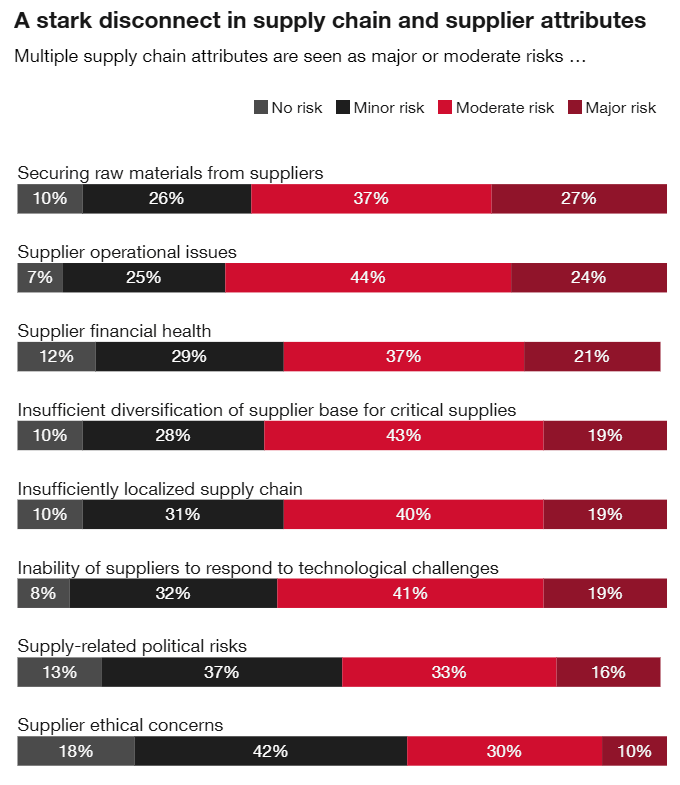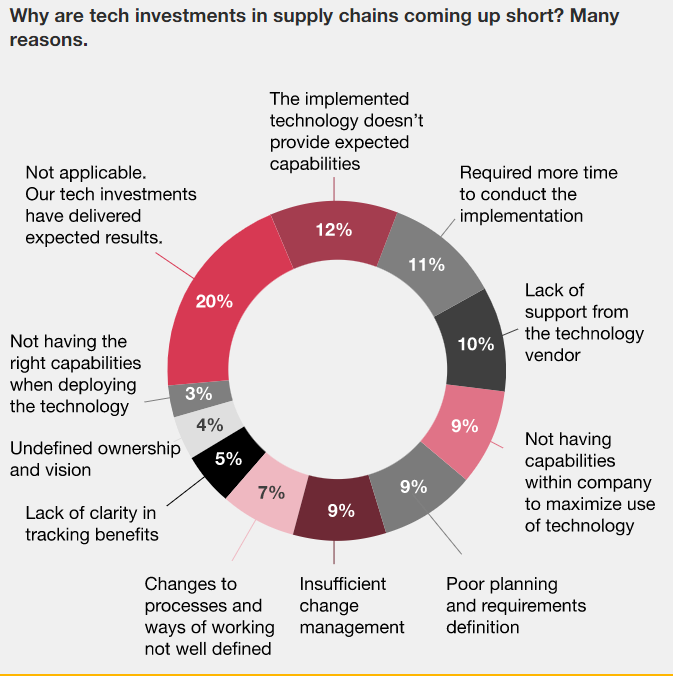Making supply chain investments, such as factory capacity and inventory, are made from historical performance rather than an understanding of future trends can spell disaster. The COVID-19 pandemic exposed many areas of weakness in the supply chain, as revealed in the PwC Digital Trends in Supply Chain Survey 2022.

Q: Please assess the risk for your organization associated with each of the following supply/supplier attributes.
Source: PwC Digital Trends in Supply Chain Survey 2022; base of 244
A Gartner survey found that 70% of respondents don’t look beyond three years when developing a vision for their digital supply chain roadmaps. And who can blame them when uncertainty and unpredictability are the norm?
How do you plan for a cloudy future – where even which technologies will emerge as critical to an organisation’s business is unclear?
Using the pandemic as an example, Alessandro Piscini, founder and co-CEO of CREA, noted that during the crisis consumer behaviour changed forcing brands to accelerate their digitalisation initiatives.
“Supply chains for brands have also had to evolve as brands move to sell their products on more digital platforms to enable them to scale their operations quickly. The change in consumer habits also resulted in a rapid digitalisation phase where brands had to find solutions to cope with their demand increase and integrate them into their existing ERPs,” he continued.
Uneven sophistication in supply chain
Piscini acknowledged that marketplace participants were at differing levels of sophistication in their digital implementations. That said, what the pandemic has made clear is the connectedness of market players.
“The pandemic has shown the reliance on each part of the supply chain, along with how intertwined it is, with the ripple effects being felt by each element, highlighting the need for firms to remain agile. Before the pandemic, we saw some big brands with minimal digital commerce solutions who were forced to accelerate their digitalisation to survive and manage the surge in demand for online sales,” he commented.
Persistent disruption in the supply chain
It’s been nearly three years since the COVID-19 pandemic disrupted the supply chain. Yet we continue to experience logistics disruption, production delays, fluctuations in commodity process, and more recently labour shortages.
According to KPMG, “operational leads have been required to shift their focus from large change projects to keeping the business running day-to-day and ensuring both staff and customers’ immediate needs are satisfied. Boards are now learning how to balance the oversight of crisis response with the strategic thinking that is required beyond these immediate challenges.”
Piscini comments that countries are recovering at different paces due to the differing timelines in experiencing new waves of infection. This, coupled with uncertainty due to geopolitical reasons, environmental factors, rising freight costs and potential disruptions in raw materials, companies, and nations, means that we are still seeing disruption to the supply chain.
“As we look to the future, businesses will need to keep looking for a ‘new working norm’ so that they can better deal with more uncertainty than ever before,” he added.
CIOs Responding to the crisis of the times
The PwC supply chain survey noted that basic priorities are outweighing others that could help create value and potentially better prepare supply chain participants from future disruptions. The silver lining is that emerging technologies are being introduced into supply chain operations, albeit inconsistency of strategies may be contributing to what PwC noted as “investments not meeting expectations.”

Source: PwC Digital Trends in Supply Chain Survey 2022; base of 244
“To cope with the uncertainty, CIOs and head of technology should look at flexible solutions that can help organisations digitalise and integrate within their existing systems,” suggested Piscini. He added that the adaptability of such solutions to cater to the organisation's various needs will be crucial to enhancing business resilience – but of course, it must be able to scale with the requirements of brands.
Readying for an uncertain future
CREA is in the business of helping brands reach consumers in Southeast Asia. It does this primarily through digital commerce and by providing them with an end-to-end solution which offers brands support with everything from their supply chain to technology to marketing.

Bringing it all together, during this period of uncertainty poses challenges to many across the supply chain. Piscini opined that the speed at which e-commerce is evolving makes integrating existing platforms tremendously tedious.
“With the complexity of managing various platforms as brands continue to develop their omnichannel approach, it will be crucial for CIOs to have a robust system to ensure that integration is precise and easily accessible.”
Alessandro Piscini
“Lastly, it is the speed and scale of transactions which CIOs need to consider. The system they have in place would need to handle the transactional volume that brands are currently facing or expecting,” he continued.
He believed that the first step is to get the C-suite and board to move in one direction will be important in addressing current issues and upcoming challenges.
“The second step is to build or find a solution that has the flexibility and the ability to help brands capture the opportunities as they come. It will be important crucial to be able to operate on a diverse range of platforms and also scale,” he concluded.
Click on the PodChat player and listen to Piscini detail the changes that were occurring across Asia’s retail sector in response to the prolonged period of uncertainty, and the evolving competitive environment.
- It is 2022, how has the supply chain ecosystem changed since the start of the pandemic till today?
- 3 years into the pandemic, we continue to see disruptions in the supply chain. Why is that?
- For CIOs and heads of technology, how should they re-architect their technology strategy and roadmap to reflect the continuing uncertainties, geopolitical volatility and emerging technologies, to enhance business resilience?
- Profile of CREA customers in SEA.
- Focusing on IT specifically, what are three key challenges facing CIOs in their quest to enhance business/operational resilience?
- What do you recommend CIOs and members of the C-suite take to solve these challenges?





